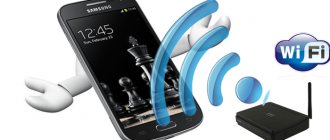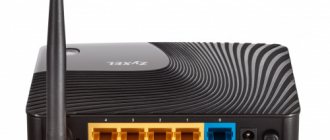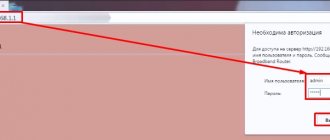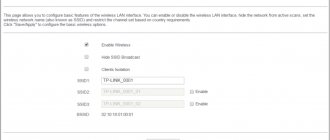Has it ever happened to you that the Internet via Wi-Fi suddenly disappeared, but on a computer or laptop that is connected directly via wire, it is there. This happened to me often on my old router. All this is connected with the WiFi module, which can overheat and freeze from a large number of network devices and needs to be “rebooted”.
So I overloaded it about 2 times a month. Later, this began to happen more often, and I bought myself a new router. Over the course of two years, I restarted it about 2-3 times. In general: if there is something wrong with your Internet, there is no connection to Wi-Fi, or another problem has arisen, then first of all we go and restart the router.
As it turns out in practice, some users are afraid to do this or do it incorrectly. And it's not their fault. The thing is that manufacturers, in addition to the usual power button, add several more. And on older models there are no “on” and “off” buttons at all. Today I will try to cover the question as fully as possible: how to simply and easily reboot or restart a router - in different ways, including remotely from anywhere in the world.
Using a button
On relatively new models, released approximately 2-3 years ago, this button is present in almost every model. Go to your router and turn its ports towards your face and towards the forest in front. And so, you should see several buttons. But we only need to click on one. Buttons can have inscriptions and pictures, but you need to choose these:
- “ON/OFF” or in English “ON/OFF”.
- May have a circle icon and sticks inside it. This is a single on/off sign that is used not only in routers.
When you press it, it will move out of the groove by a few millimeters. Then wait 15-20 seconds and press it again to turn on the device. As practice has shown, many users are in a hurry and press the wrong buttons. The most important thing is not to press the following buttons:
!!!DO NOT PRESS!!!
- “ Fn” – automatically downloads the latest update from the Internet. And if in the process you start to reboot the router, the system will crash and nothing will work. You will have to reset to factory settings and configure the router using standard firmware.
- “R ESET” – if you press this button for 12-15 seconds, the router configuration will be reset to the factory one. Sometimes combined with the “WPS” button.
NO POWER BUTTON! As I said, not all routers have a power button. In this case, it is better to reboot it via the Web interface or TELENET. I wrote about all this below in the article.
Quick method
The easiest and fastest way to reboot is to click on the appropriate button. Not all routers have it, but most have it. The button is designated as follows:
POWER or On/Off
It is located close to the connection connectors on the back panel of the device. Try pressing the button once. Look at the indicator lights. If nothing has changed, press again - twice or simply hold down the button. The blinking of the lamps will change, which will characterize the current reboot state.
There is one caveat. When you press a button, you should not expect that the restart will take place immediately. First, the process of turning off the device begins, then, after about a minute, you can press it again, and then the router will turn on. This is the easiest way to restart the network.
If there is a Reset symbol on the back panel of the router, you do not need to press it twice. In new models, instead of a button, a lever, a touch panel, or a small bulge may be installed, under which a reboot indicator is located.
The Reset button completely resets the settings. If your router previously worked according to certain parameters, you need to enter them again. Many modern models do not require such a need - they are equipped with a smart configuration function, when the reset affects only the operation of the firmware, and not changing data in the system.
Attention! To avoid resetting the settings, hold down the reset or power button for no longer than two seconds. In the case of many models, this saves the need for reconfiguration.
If Wi-Fi is lost, a good option would be to turn off the router from the network. You just need to unplug the plug from the outlet and wait about 10 seconds, then connect again. The Internet should appear if the problem was only a frozen router.
It is better not to practice the latter often. An emergency shutdown is not considered a safe method of restoring the operation of the router - it may gradually break down.
Via Web interface
This method is the most reliable and most importantly correct, since the system itself will control the reboot of the device. There is nothing complicated, first we need to connect to the router’s network. This can be done in two ways:
- Via Wi-Fi - just connect to it from your laptop, tablet, or phone as standard.
- Through a wire , one end is inserted into the LAN port of the router (yellow), and the other into the network card of a laptop or computer. It doesn’t matter what Windows operating system you have (7, 8 or 10).
Next, from any device connected to the local network, you need to go to the browser. In the address bar, enter the IP or DNS address of the router. It is located on the label under the case.
Login addresses are different, so you need to look at the label on your model. We enter this address into the browser in the address bar, which is located at the very top.
Do not confuse this with the search engine string. After this, you should see a window where you will be asked to enter your username and password. If you noticed, this information is also on a piece of paper under the router. Further instructions will differ slightly depending on the model and brand of the router.
TP-Link
Old models
“System Tools” – “ Reboot” – Click on the restart button and reboot.
New models
In the upper left corner of the TP-Link interface window there will be a “Reboot” or “ Reboot” button.
D-Link
Old firmware
“System” – “Configuration”.
New firmware
At the very top, click on the “System” button, then select either the first option, or the second, if you changed some settings - for example, the Wi-Fi password.
ASUS
You will find the reboot button right at the very top.
Zyxel Keenetic
Click on the gear icon. Then scroll to the very bottom and click on the button.
Routers Rostelecom
Usually these are Sagemcom [email protected] 2804 and 3804 models. Go to the “Management” , then “Reboot” and click on the button.
Why reboot?
A router is the same device as a computer or tablet. It has a processor, RAM and permanent memory into which the control microprogram is written. Just like a computer, a router can freeze or start to glitch. Why is this happening?
Main causes of failures:
- The program failed.
- Sudden power surge.
- External interference.
Let's consider these situations.
Program crash
The control program is responsible for the operation of the router, and any program is imperfect. During operation, errors accumulate and failures occur. On a computer, such failures lead to the failure of some functions. The longer the router runs without turning off, the more errors there are. Conscientious manufacturers usually write reliable code and then test it for a long time. So such problems are unlikely, but possible.
For example, during long-term continuous operation, the device’s memory may become full, and it will begin to perform worse until it stops completely. The processor may also malfunction due to an internal failure or increased load. We can observe similar phenomena on a computer - when, due to lack of memory or 100% processor load, programs stop working, or even the operating system crashes.
Power surge
A protective microcircuit is usually installed on the equipment. For example, there was a power surge. As a result, the power supply produced incorrect internal voltage. In this case, the security chip automatically reboots the router. If there is a problem with the power supply, the router may reboot on its own.
External interference
RAM is highly susceptible to external radiation. Of course, developers are trying to design the most compact device possible. In this case, the influences of various interferences are taken into account. But often very strong radiation can affect RAM and cause software failure. Also, interference can cause failures during the exchange of information between microcircuits. Because of this, the router may stop distributing the Internet until the next reboot.
Try to place the router in such a way as to limit its exposure to radiation from other devices.
Failures on the provider's side are unlikely to cause problems on the router. Of course, the provider may not have a reliable switch to which you are connected. And by the fact that you rebooted the router, you simply reset the link.
In all of the above cases, first of all, problems on the router affect the quality of the Internet. The speed drops or the Internet disappears altogether. In this case, you need to reboot it.
What happens to the router when it reboots?
The same as with a regular computer.
First of all, the device memory is cleared. All software junk is removed, and the router starts working from scratch. The settings are, of course, saved.
The ARP table is being cleared. The router will update information about all devices connected to it.
The connection may be restored. In this case, the freest Wi-Fi channel that is not overloaded by other users will be selected, which significantly increases the data transfer speed.
In addition to the reasons listed above, a reboot is usually required to apply new settings or updates on the router. Most often it happens automatically, but in some cases a manual reboot may be required. Here, too, everything is similar to a PC: after adding new devices, installing programs or changing system settings, we reboot the computer in the same way for the OS to work correctly.
The easiest way
Simply unplug the power cord that comes from the outlet. Wait a couple of minutes and then put it back in. You will have to wait a bit until the router system boots up again. You can unplug it either from the router or simply from the socket - as you wish. I would not recommend this method, since the system reboots uncontrollably. But if you don’t know how else to do a reboot, then you can use this simple method.
Is it necessary to unplug the device from the outlet?
Disconnecting the router from the power supply is a forced method of restarting it, which is recommended as a last resort.
You can always reboot the device using standard methods that will not lead to failures in its operation in the future. Therefore, unplugging the Wi-Fi router's power cord from the outlet to reset it is neither practical nor correct.
Router connection diagram
Reboot via command line or PuTTY
- Press + R at the same time.
- Enter the command “CMD” and click “OK”.
- We write the command:
telnet IP_address_of_your_router
- Press Enter. Next we write:
reboot
- If you see a message that there is no such command, then you can reboot through the excellent PuTTY program. Go to the website and download for your operating system - https://www.chiark.greenend.org.uk/~sgtatham/putty/latest.html.
- Now let's install the program.
- After launching, in the “Host Name (or IP address)” line, enter the IP of your router. Specify the connection type as “Telnet” and click “Open”. Next we simply write the command:
reboot
- If an error occurs, press the “Tab” button to see all the system commands - on some models this command may be slightly different.
You can also log in through this program if you configure a port, IP or DNS address on the router for remote access. I will talk about this in the following chapters.
Network cable not connected
If, when checking the connection status, a message appears that the network cable is not connected, the first thing to do is actually check that it is connected correctly and is not damaged. If possible, try using a different network cable.
Make sure the cable is connected correctly. On the router, the network cable must be connected to the WAN or INTERNET port, and the cable leading from the router to the computer must be connected to the LAN connector. There is usually only one port on a computer, so it will be difficult to make a mistake.
The WAN or INTERNET port is used to connect a network cable to the router, and the LAN ports are used to route cables to computers.
Next, check the status of the router (if you have one). Its indicators should light up as usual. If there is no indication, reconnect the router to another outlet, try resetting the settings on the router (using the “Reset” or “Reset” button) and entering them again. You should reset the settings only if you are confident that you can configure the router yourself.
Also check the status of your network adapter drivers and try updating them.
Video: checking the port on the network card and the WAN port on the router
Remote router reboot
Everything is much more complicated here. In theory, any router can be configured to access it from the Internet. In the router settings, you need to register a certain rule under which you can access your router from the outside, as well as connected devices, from an IP or DNS address.
The only problem is that your provider, from which the Internet goes to the router, must provide a “white address” or “static”. That is, you can connect to this address from the Internet. But you can also connect through a “gray address”. And now I will show you the example of my Zyxel Keenetic Omni II.
- As soon as you get into the settings, go to “Applications”. This section is in the lower right corner and has a four dice icon.
- Next, we will be asked to enter the DNS name by which we will have access to the router. Come up with a name that only you remember, but also that it is original. Click “Check”.
- The system will check the domain name and provide available options. You can choose any one.
- Look at the window that popped out for me. My provider uses a non-dedicated address - this means that access must be configured “Through the cloud”. Click on “Operation Mode” and select this option, and then click on the “Apply” button. If this message is not present, then leave the “Direct Access” mode.
- That’s it, now we copy our address from the “Internet center address” and paste it into the address bar. As you can see, we were able to log into the router without even the name of the “White Address”. Now enter your username and password and appear in our router. You can log in this way from anywhere in the world where there is Internet.
Restart by time
Users can configure automatic restart. In this case, the reboot will be carried out according to schedule. The schedule will be saved in the router's non-volatile memory. The schedule can be programmed via the command line. Netis models have a special option in the control panel. You can go to the web interface, open the appropriate section and configure the restart schedule. You can reboot the router at least every day. The system will carry out the process automatically.
Setting up remote access for white addresses
As I said earlier, you need your ISP to provide you with a static external IP address. To find out about this, just call your provider's hotline.
Look, our task is to set the port number in the router (I will use 80). And the IP address from which you will log in. That is, for example, you have a computer at work, also with a static address. So, in order for you to be able to log in only from this PC, you just need to assign the IP of the working PC on your home router.
If there is no static, then we simply enter the value 255.255.255.255, which will mean that a device with any IP can access your router from the Internet. Let's summarize, we need to write:
- Port.
- IP address of the external device or 255.255.255.255 if there is no static IP.
All! Now I will write where to find this in the administrator Web panel on different routers. And at the very end I’ll write how to log in from another device.
TP-Link
“Protection” – “Remote control”. After everything, do not forget to save the settings.
If you have new firmware, then everything is much simpler. Go to: “Basic setup” and “TP-Link Cloud” . Just register and follow the instructions. This way you can control and access the device settings anywhere, even if you do not have a “White Address”.
D-Link
On new firmware, go to “Advanced settings” and in the “Advanced” tab, find the “Remote device access” section.
After that, click add and enter the data. In the first column, enter 0.0.0.0, and then 255.255.255.255 and the port. Finally, click on the “Apply” button.
On older firmware, everything is done in the same way in the “Advanced” section - “Remote access to the device”.
ASUS
In the ASUS settings, go to: “Internet” – “ DDNS”. Turn on the service and select the service. Enter the host name. Click Apply. Now you can log into your router using this address. Don't forget the value after the dot as well.
How to log in now
These instructions are for those who registered an IP or installed a mask for TP-Link and D-link. First you need to find out the external IP address of the router. To do this, from any device that is connected to your home router, go to https://2ip.ru/. There you will see the external IP address. Write it down somewhere or take a photo.
Now, from any device, go to the browser and enter the following address:
IP:port you specified
Well, for example: you specified the port as “80”, and the external IP, for example 196.35.39.233. Then the line in the address bar will look like this:
196.35.39.233:80
Next, enter your username and password and log into the router, and then reboot it.
Files cannot be downloaded from the Internet
It may also happen that Internet access is active, but files are not downloaded. This problem is usually associated not with the Internet itself, but with the computer and software.
What you can try:
- try to download a file from another source - perhaps you are unable to download something simply because the resource does not support downloading;
- try downloading through other browsers;
- check your computer for malware using any official antivirus.











